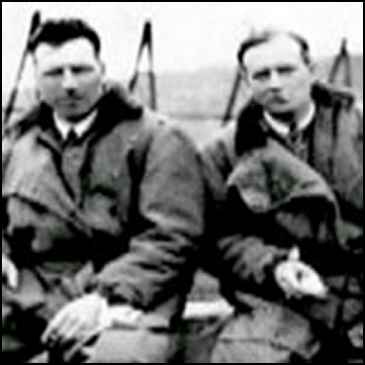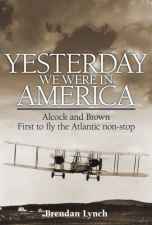
1892-1919 |
 |
Sir John William Alcock & Sir Arthur Whitten Brown
"In 1919, John Alcock and
Sir Arthur Whitten Brown made the first nonstop transatlantic
flight when they flew from Newfoundland, Canada to County Galway, Ireland. The more than 3,000 kilometer trip
lasted just over 16 hours.Over the course of their flight the pair got lost in sleet and darkness, Sir Arthur Whitten Brown was forced to climb out of the cockpit to clear ice from the plane, they went into uncontrolled spins, at times were forced to fly upside down, and finished the flight with a crash landing" Photograph & legend from:
newsVOA.com |
|
Sir John William Alcock, and Chief Pilot Shakir S. Jerwan---"all licensed aviators," as the prospectus put it The Story of the Early Birds Thomas Y. Crowell Co. |
|
|
|
The First Non-Stop Aerial Crossing of the Atlantic |
|
"Flights of Inspiration" was created by The Franklin Institute Science Museum and the Science Museum, London in affiliation with the Science Learning Network a program of Unisys and leading science museums, worldwide." It offers brief biographies of both Sir John William Alcock and Arthur Whitten Brown as well as sections on Before the Flight, The Flight, After the Flight and The Aircraft. You can access the site by clicking on the title above. |
|
If you want to learn more of the details of the story, you have available a multitude of links. |
 |
Yesterday We Were in America Brendan Lynch Product Details Hardcover: 256 pages Publisher: Haynes Publishing (November 1, 2009) List Price: $23.07 ISBN-10: 1844256812 ISBN-13: 978-1844256815 |
|
Editorial Reviews from Amazon.com On 14 June 1919 Sir John William Alcock and Arthur Whitten Brown took off from Newfoundland in their open-cockpit Vickers Vimy converted bomber to attempt a non-stop crossing of the Atlantic. Some 16 hours later they landed at Derrygimla in Connemara, Ireland, to become national heroes. Navigating blind for most of the way, they had flown almost 1,900 miles, the longest distance ever flown by man. In researching one of the most significant flights in history, Brendan Lynch has drawn on the written records of Alcock and Brown, and interviewed the last surviving witness of their dramatic arrival in Ireland and the adventurer Steve Fossett, who recreated the flight in 2005. |
|
If you have any information on this Early Flier, please contact me. E-mail to Ralph Cooper Back 

|